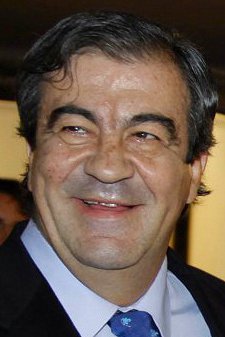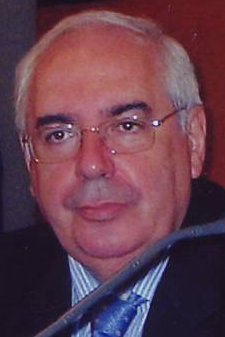Related Research Articles

The President of the Principality of Asturias ; Asturian: Presidente del Principáu d'Asturies) is the head of government of the Spanish autonomous community of Asturias. The president is chosen by the General Junta of the Principality of Asturias, autonomous parliamentary institution.

The coat of arms of Asturias was adopted on 27 April 1984.
The Divisiones Regionales de Fútbol in the Community of Asturias, organized by Real Federación de Fútbol del Principado de Asturias:

The 2011 Asturian regional election was held on Sunday, 22 May 2011, to elect the 8th General Junta of the Principality of Asturias. All 45 seats in the General Junta were up for election. The election was held simultaneously with regional elections in twelve other autonomous communities and local elections all throughout Spain.

The 2012 Asturian regional election was held on Sunday, 25 March 2012, to elect the 9th General Junta of the Principality of Asturias. All 45 seats in the General Junta were up for election. The election was held simultaneously with a regional election in Andalusia.
José Manuel González Santamaría is a paralympic athlete from Spain competing mainly in category T36 track events.

The 1987 Asturian regional election was held on Wednesday, 10 June 1987, to elect the 2nd General Junta of the Principality of Asturias. All 45 seats in the General Junta were up for election. The election was held simultaneously with regional elections in twelve other autonomous communities and local elections all throughout Spain, as well as the 1987 European Parliament election.

The 1995 Asturian regional election was held on Sunday, 28 May 1995, to elect the 4th General Junta of the Principality of Asturias. All 45 seats in the General Junta were up for election. The election was held simultaneously with regional elections in twelve other autonomous communities and local elections all throughout Spain.

The 1999 Asturian regional election was held on Sunday, 13 June 1999, to elect the 5th General Junta of the Principality of Asturias. All 45 seats in the General Junta were up for election. The election was held simultaneously with regional elections in twelve other autonomous communities and local elections all throughout Spain, as well as the 1999 European Parliament election.

The 2003 Asturian regional election was held on Sunday, 25 May 2003, to elect the 6th General Junta of the Principality of Asturias. All 45 seats in the General Junta were up for election. The election was held simultaneously with regional elections in twelve other autonomous communities and local elections all throughout Spain.

The 2007 Asturian regional election was held on Sunday, 27 May 2007, to elect the 7th General Junta of the Principality of Asturias. All 45 seats in the General Junta were up for election. The election was held simultaneously with regional elections in twelve other autonomous communities and local elections all throughout Spain.

The Asturian Socialist Federation, often shortened to FSA–PSOE, is the regional section of the Spanish Socialist Workers' Party (PSOE) in the Principality of Asturias. It was formed on 27 January 1901 from the Socialist local groupings of Gijón, Oviedo (1892), Mieres and Langreo (1897) and others.

Central District is one of the three constituencies represented in the General Junta of the Principality of Asturias, the regional legislature of the Principality of Asturias. The constituency currently elects 34 deputies. It comprises the municipalities of Aller, Avilés, Bimenes, Carreño, Caso, Castrillón, Corvera de Asturias, Gijón, Gozón, Illas, Las Regueras, Langreo, Laviana, Lena, Llanera, Mieres, Morcín, Noreña, Oviedo, Proaza, Quirós, Ribera de Arriba, Riosa, San Martín del Rey Aurelio, Santo Adriano, Sariego, Siero, Sobrescobio and Soto del Barco. The electoral system uses the D'Hondt method and a closed-list proportional representation, with a minimum threshold of three percent.

Western District is one of the three constituencies represented in the General Junta of the Principality of Asturias, the regional legislature of the Principality of Asturias. The constituency currently elects six deputies. It comprises the municipalities of Allande, Belmonte de Miranda, Boal, Candamo, Cangas del Narcea, Castropol, Coaña, Cudillero, Degaña, El Franco, Grado, Grandas de Salime, Ibias, Illano, Muros del Nalón, Navia, Pesoz, Pravia, Salas, San Martín de Oscos, Santa Eulalia de Oscos, San Tirso de Abres, Somiedo, Tapia de Casariego, Taramundi, Teverga, Tineo, Valdés, Vegadeo, Villanueva de Oscos, Villayón and Yernes y Tameza. The electoral system uses the D'Hondt method and a closed-list proportional representation, with a minimum threshold of 3%.
Covadonga Romero Rodríguez was a Spanish sculptor and painter, a pioneer of the women's avant-garde of Asturias.

The first government of Adrián Barbón was formed on 25 July 2019, following the latter's election as President of the Principality of Asturias by the General Junta of the Principality of Asturias on 15 July and his swearing-in on 17 July, as a result of the Spanish Socialist Workers' Party (PSOE) emerging as the largest parliamentary force at the 2019 regional election. It succeeded the second Fernández government and was the incumbent Government of the Principality of Asturias between 25 July 2019 and 31 July 2023, a total of 1,467 days, or 4 years and 6 days.

The 2023 Asturian regional election was held on Sunday, 28 May 2023, to elect the 12th General Junta of the Principality of Asturias. All 45 seats in the General Junta were up for election. The election was held simultaneously with regional elections in eleven other autonomous communities and local elections all throughout Spain.

The Second Javier Fernández government was the regional government of Asturias led by President Javier Fernández. It was formed in July 2015 after the regional election.

The 12th General Junta is the current meeting of the General Junta, the parliament of the Principality of Asturias, with the membership determined by the results of the regional election held on 28 May 2023. The congress met for the first time on 26 June 2023, with a maximum term of four years.
References
- 1 2 "Ley 4/1986, de 15 de mayo, reguladora de los honores y distinciones del Principado de Asturias" [Law 4/1986, of May 15, Regulating the Honors and Distinctions of the Principality of Asturias](PDF). Boletín Oficial del Estado (in Spanish) (153). 27 June 1986. Retrieved 4 February 2020.
- 1 2 3 "Estas son todas las medallas de Asturias 2019" [These are All of the 2019 Medals of Asturias]. La Voz de Asturias (in Spanish). Oviedo. 14 August 2019. Retrieved 4 February 2020.
- 1 2 3 4 5 6 7 8 9 10 11 12 13 14 15 16 17 18 "Medalla de Asturias". Enciclopedia de Oviedo (in Spanish). Retrieved 4 February 2020.
- ↑ "Acuerdo de 3 de septiembre de 2008, por el que seconcede la Medalla de Asturias, en su categoría de oro, a la Universidad de Oviedo" [Agreement of 3 September 2008, for the Granting of the Medal of Asturias, in its Gold Category, to the University of Oviedo](PDF). Boletín Oficial del Principado de Asturias (in Spanish) (208): 20020. 5 September 2008. Retrieved 4 February 2020.
- ↑ "Asturias entrega sus medallas" [Asturias Presents its Medals]. La Nueva España (in Spanish). EFE. 7 September 2012. Retrieved 4 February 2020.
- ↑ Ardura, J.A.; Palicio, Marcos (6 August 2014). "El Padre Ángel, medalla de oro de Asturias". La Nueva España (in Spanish). Retrieved 4 February 2020.
- ↑ "La Corporación Masaveu, Medalla de Oro de Asturias". El Comercio (in Spanish). 19 August 2015. Retrieved 4 February 2020.
- ↑ "Asturias concede sus medallas de oro y plata" [Asturias Presents its Gold and Silver Medals]. La Voz de Asturias (in Spanish). EFE. 3 August 2016. Retrieved 4 February 2020.
- ↑ "El Consejo de Gobierno concede la Medalla de Oro de Asturias a Plácido Arango por su singular relación con el Principado y su valioso impulso al Museo de Bellas Artes" [The Council of Government Awards the Gold Medal of Asturias to Plácido Arango for His Unique Relationship with the Principality and His Valuable Boost to the Museum of Fine Arts](PDF) (in Spanish). Council of Government of the Principality of Asturias. 2 August 2017. Retrieved 4 February 2020.
- 1 2 "El Consejo de Gobierno concede la Medalla de Oro de Asturias a los descubridores de Tito Bustillo y a los centros asturianos centenarios" [The Council of Government Awards the Gold Medal of Asturias to the Discoverers of Tito Bustillo and the Asturian Centennial Centers] (in Spanish). Council of Government of the Principality of Asturias. 8 August 2018. Retrieved 4 February 2020.